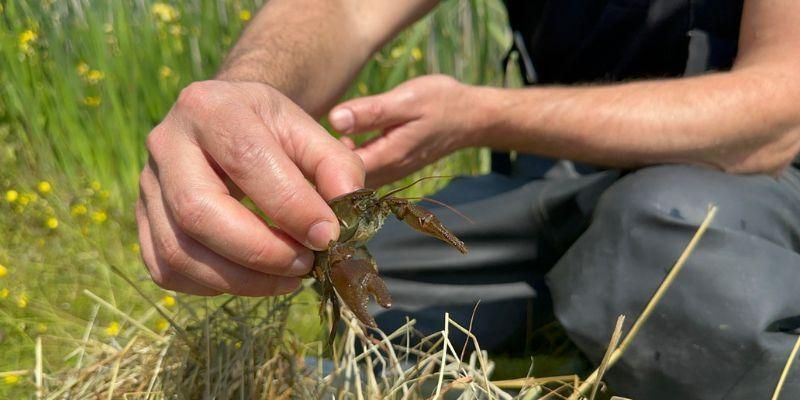
A rescued population of endangered white clawed crayfish that were in danger of being wiped out have been moved to the University’s Bodington Pond, where they can thrive and breed.
Last month, Environment Agency biodiversity specialists and University of Leeds researchers rescued the population from Meanwood Beck in Leeds, where crayfish plague was detected during water sampling.
Those rescued, which included females carrying eggs, were kept in quarantine at York Gate Garden and the University of Leeds before passing health checks to ensure they were plague free.
Most have now been released into Bodington Pond, located at Bodington Fields, where they can thrive and breed before being released back into the wild.
Bodington Pond was originally constructed to reduce flood risk in the River Aire catchment, but it also enhances biodiversity and provides opportunities for students, academics and partners to collaborate on research projects.
The rescue and release is part of work by the Environment Agency and partners to carry out operations to rescue the native species after the invasive signal crayfish and a disease it carries – crayfish plague – moved through parts of the River Aire catchment.
In the coming weeks, officers will also carry out a rescue at Pudsey Beck, where the presence of signal crayfish has been confirmed.
Ann Allen, Director of Campus Innovation & Development at the University of Leeds, said: “Bodington Pond was originally constructed to reduce flood risk in the River Aire catchment, but it also enhances biodiversity and provides opportunities for students, academics and partners to collaborate on research projects.
“We’re delighted to work in partnership with the Environment Agency and colleagues across the University to welcome our brand-new residents.”
Environment Agency biodiversity specialist Tim Selway, who is leading the project, said: "With so few populations of native crayfish remaining, we must act to preserve what we can.
"The endangered white-clawed crayfish plays a vital role in keeping our waterways clean and as a source of food for other native species, so it’s vital we take action to ensure its survival.
“Those rescued from Meanwood Beck are now on the next step of their journey and will be cared for at the University before going back into the wild in future. We’ll be carrying out further operations to rescue more crayfish from the deadly invasive signal and the disease it carries in the coming months.”
Invasive species and diseases are a growing challenge for native wildlife so it’s really important that everyone plays their part in reducing the risk.
Rare white-clawed crayfish are the UK’s only native, freshwater crayfish, and are most at risk from signal crayfish, which spread crayfish plague and compete for food. They have struggled to survive after the more aggressive signal crayfish population has taken hold across the country.
The Agency and University are calling for people to play their part by making sure they “Check, Clean and Dry” to prevent the spread of invasive species.
Alison Dunn, Professor of Ecology in the School of Biology at the University of Leeds, who has been involved throughout the project, said: “Invasive species and diseases are a growing challenge for native wildlife so it’s really important that everyone plays their part in reducing the risk.
“The good news is there are things you can do to help stop the spread if you’re near any rivers or lakes for recreation or work. Simple steps, such as checking, cleaning and drying your equipment and boots, make a big difference to native species like the white-clawed crayfish.”
What to do if you see crayfish
If you see crayfish or other species, leave them there. Do not move animals or plants to a new river or lake and do not use crayfish as angling bait as this could spread invasive species or diseases. Anything that has contact with the water and riverbank needs to be cleaned thoroughly, using hot water if possible. The use of an environmentally friendly aquatic disinfectant is also recommended. This will make sure all aquatic diseases and invasive species are killed. More information can be found on the Invasive non-native species website
If you see any crayfish, alive or dead, leave it where it is and report it immediately to the Environment Agency on 0800 807060. If possible, take close-up photos of the crayfish to help identify the species. It is illegal to handle or remove crayfish from the water without the correct licences.
History of white clawed crayfish in Yorkshire
Historically white-clawed crayfish were common in Yorkshire, being perfectly adapted to its clean, calcium-rich waters and stony-bedded rivers and streams. The legacy of the industrial age drastically impacted populations but they did survive. However, despite improvements in water quality in recent decades many white-clawed crayfish populations have now been wiped out as signal crayfish populations expand throughout Yorkshire.
Further information
For media enquiries, email Kate Ashman, Faculty of Biological Sciences Communications Manager.